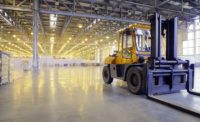4 steps to hiring, retaining skilled workforce
More and more employees are entering supply chain or manufacturing jobs lacking basic mechanical skills.

Rick Harrington, The Raymond Corp.
If you’re in the supply chain industry, you are most likely already experiencing the impact of the talent shortage. More and more, employees entering supply chain or manufacturing jobs are lacking basic mechanical skills, and the hiring company needs to know how to help new employees learn and succeed. Because of the shortage and shift in the kind of talent available, it’s more important than ever to find, hire, train and retain a skilled workforce.
1. Embrace new technology.
Although those entering the supply chain industry are lacking hands-on manufacturing or technical skills, they seem to excel at technology. This is ideal because innovative technology is constantly changing the supply chain industry, and this new generation of employees can help with the transition while the technology itself can attract and retain talent.
An example is the use of virtual reality (VR). When used for training someone like a forklift operator, VR can help new employees feel more comfortable with equipment or vehicles before joining others on the warehouse floor. VR training allows operators to work lift trucks in simulation mode using pre-programmed exercises. With a VR headset, the user is immersed into an enhanced training experience that simulates the movement and feel of operating in a warehouse environment.
2. Apply employees’ skills; automate the rest.
New and already established generations alike generally prefer to do meaningful work that requires thought and skill. This is where automation can help. By automating redundant and sometimes tremendously demanding tasks, employees can instead focus time and skillsets on value-added positions. Truly redundant and repetitive tasks like transporting and transitioning materials through a warehouse can be automated through automated guided vehicles (AGVs). Robotic machinery, as well, will continue to become prevalent in factory settings, which will help workplace efficiency and increase the bottom line.
As a complement to common automation solutions, navigation solutions can help increase productivity and safety with aisle and zone identification and point-to-point positioning. Simply put, navigation solutions automate which trucks and operators can go where and how fast by using RFID tags. Specifically, navigation solutions are best suited for very narrow aisle (VNA) applications, in which numerous tight turns, height varieties for lifts and speed changes are required. As an operator enters a VNA area, the truck will automate the speed changes required to make tight turns and raise the lift to the appropriate height before automatically lowering it before speed increases again.
3. Don’t lose sight of the technician or training.
For decades, the industry has operated with long-time, dedicated technicians who knew equipment — like forklifts — front to back. Now, we’re seeing fewer technicians enter the workforce. Ideally, candidates would come on board with a mix of hard technical skills and soft customer service skills for technician roles. That’s just simply not the case in today's climate. Often, technicians cite a lack of continuous education or training as a reason to leave. By keeping new technicians learning, especially when it comes to new technologies, companies can keep them in-house. This training and continuous learning not only helps improve the workforce, but also helps technicians look forward to the future. Keeping employees requires showing them a future at your company.
4. Prepare the next generation.
The most crucial piece of the talent shortage puzzle is the next generation. Collaborating with educational institutions such as high schools, local universities and technical schools to introduce supply chain careers early on and set expectations is an extremely helpful step companies can do now. Through these types of collaborations, companies can pique interest from potential candidates, educate them early on to be more qualified candidates later and help set the expectations for what the employee would get hired to do.
The best way to introduce students to supply chain industry careers is through a combined effort of taking manufacturing floor tours and discussing careers that involve new technologies and advanced processes. These tours and discussions can help younger students comprehend job responsibilities and picture themselves in the position.
Focusing collectively on technology, automation, training, technicians and the next generation of employees may be the ultimate combination for overcoming the labor shortage with better talent attraction and retention.
Looking for a reprint of this article?
From high-res PDFs to custom plaques, order your copy today!




